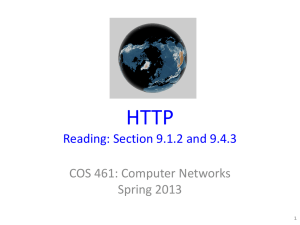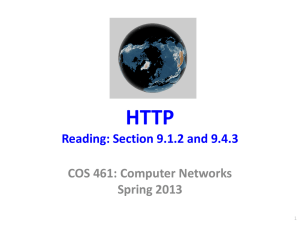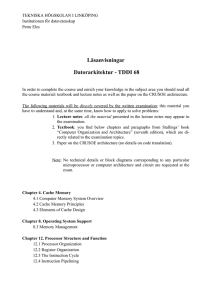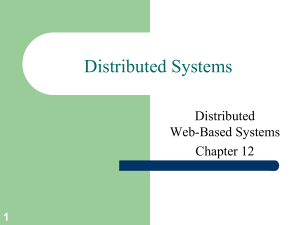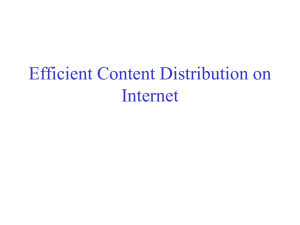HTTP Reading: Section 9.1.2 and 9.4.3 COS 461: Computer Networks Spring 2012
advertisement
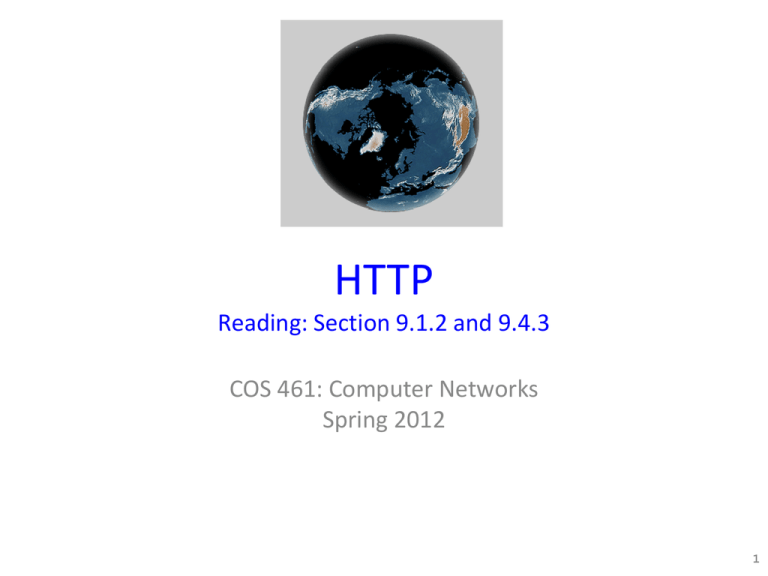
HTTP Reading: Section 9.1.2 and 9.4.3 COS 461: Computer Networks Spring 2012 1 Outline • HTTP overview • Proxies • Persistent HTTP • HTTP caching 2 Application Layer Protocols • Variable Headers vs. Fixed Headers – App headers handled by program rather than hardware – Variable headers allow for incrementally adding features • Human Readable – Easy for programmers to reason about – Parsed by humans / programs rather than hardware • More later on, but useful for understanding HTTP’s design 3 HTTP Basics (Overview) • HTTP layered over bidirectional byte stream – Almost always TCP • Interaction – Client looks up host (DNS) – Client sends request to server – Server responds with data or error – Requests/responses are encoded in text • Stateless – Server maintains no info about past client requests4 HTTP Request “cr” is \r “lf” is \n sp is “ “ 5 HTTP Request • Request line – Method • GET – return URI • HEAD – return headers only of GET response • POST – send data to the server (forms, etc.) – URL (relative) • E.g., /index.html – HTTP version 6 HTTP Request (cont.) • Request headers – Variable length, human-readable – Uses: • • • • • • Authorization – authentication info Acceptable document types/encodings From – user email If-Modified-Since Referrer – what caused this page to be requested User-Agent – client software • Blank-line • Body 7 HTTP Request Example GET /index.html HTTP/1.1 Host: www.example.com 8 HTTP Request Example GET /index.html HTTP/1.1 Host: www.example.com Accept-Language: en-us Accept-Encoding: gzip, deflate User-Agent: Mozilla/4.0 (compatible; MSIE 5.5; Windows NT 5.0) Connection: Keep-Alive 9 HTTP Response 10 HTTP Response • Status-line – HTTP version – 3 digit response code • 1XX – informational • 2XX – success – 200 OK • 3XX – redirection – 301 Moved Permanently – 303 Moved Temporarily – 304 Not Modified • 4XX – client error – 404 Not Found • 5XX – server error – 505 HTTP Version Not Supported – Reason phrase 11 HTTP Response (cont.) • Headers – Variable length, human-readable – Uses: • • • • • • • • • Location – for redirection Server – server software WWW-Authenticate – request for authentication Allow – list of methods supported (get, head, etc) Content-Encoding – E.g x-gzip Content-Length Content-Type Expires (caching) Last-Modified (caching) • Blank-line • Body 12 HTTP Response Example HTTP/1.1 200 OK Date: Tue, 27 Mar 2001 03:49:38 GMT Server: Apache/1.3.14 (Unix) (Red-Hat/Linux) mod_ssl/2.7.1 OpenSSL/0.9.5a DAV/1.0.2 PHP/4.0.1pl2 mod_perl/1.24 Last-Modified: Mon, 29 Jan 2001 17:54:18 GMT Accept-Ranges: bytes Content-Length: 4333 Keep-Alive: timeout=15, max=100 Connection: Keep-Alive Content-Type: text/html ….. 13 How to Mark End of Message? • Content-Length – Must know size of transfer in advance • Close connection – Only server can do this • Implied length – E.g., 304 never have body content • Transfer-Encoding: chunked (HTTP/1.1) – After headers, each chunk is content length in hex, CRLF, then body. Final chunk is length 0. 14 Example: Chunked Encoding HTTP/1.1 200 OK <CRLF> Transfer-Encoding: chunked <CRLF> <CRLF> 25 <CRLF> This is the data in the first chunk <CRLF> 1A <CRLF> and this is the second one <CRLF> 0 <CRLF> • Especially useful for dynamically-generated content, as length is not a priori known – Server would otherwise need to cache data until done generating, and then go back and fill-in length header before transmitting 15 Outline • HTTP overview • Proxies • Persistent HTTP • HTTP caching 16 Proxies • End host that acts a broker between client and server – Speaks to server on client’s behalf • Why? – Privacy – Content filtering – Can use caching (coming up) 17 Proxies (Cont.) • Accept requests from multiple clients • Takes request and reissues it to server • Takes response and forwards to client origin server Proxy server client client origin server 18 Assignment 1 • Non-caching, HTTP 1.0 proxy – Support only GET requests • Multi-process – Use fork() • Simple binary that takes a port number – ./proxy 12345 (proxy listens on port 12345) • Work in Firefox & Chrome – Use settings to point browser to your proxy 19 Assignment 1 (Cont.) • What you need from a client request: host, port, and URI path – GET http://www.princeton.edu:80/ HTTP/1.0 • What you send to a remote server: – GET / HTTP/1.0 Host: www.princeton.edu:80 Connection: close • Check request line and header format • Forward the response to the client 20 Assignment 1 (Cont.) • Non-GET request? – return “Not Implemented” (code 501) • Unparseable request? – return “Bad Request” (code 400) • Use provided parsing library • Postel’s law – – – – Be liberal in what you accept, and conservative in what you send convert HTTP 1.1 request to HTTP 1.0 convert \r to \r\n etc 21 Advice • Networking is hard – Hard to know what’s going on in network layers – Start out simple, test often • Build in steps – Incrementally add pieces – Make sure they work – Will help reduce the effect of “incomplete” information 22 Assignment 1 – Getting Started • Modify Assn 0 to have server respond – Simple echo of what client sent • Modify Assn 0 to handle concurrent clients – Use fork() • Create “proxy” server – Simply “repeats” client msg to a server, and “repeats” server msg back • Client sends HTTP requests, proxy parses 23 Outline • HTTP overview • Proxies • Persistent HTTP • HTTP caching 24 Problems with simple model • Simple model – request one object a time, sequentially • Multiple connection setups – Connection setup for each item (imgs, js, etc) • Short transfers are hard on TCP • Lots of extra connections – Increases server state/processing 25 Persistent HTTP • Reuse connection – Request header “Connection: Keep-Alive” – Reduces # of connection setups • Benefits – Reduces server overhead – Reduces latency (i.e., faster page loads) – Allows pipelining 26 Pipelining • Issue multiple requests at a time – Don’t have to wait for previous response – More efficient use of link • Use carefully – POST requests should not be pipelined (changes server state) – GET/HEAD requests are usually okay 27 Persistent HTTP Non-persistent HTTP issues: Persistent without pipelining: • Connection setup for each request • But browsers often open parallel connections • Client issues new request only when previous response has been received • One RTT for each object Persistent HTTP: Persistent with pipelining: • Server leaves connection open after sending response • Subsequent HTTP messages between same client/server are sent over connection • Default in HTTP/1.1 spec • Client sends multiple requests • As little as one RTT for all the referenced objects • Server must handle responses in same order as requests 28 “Persistent without pipelining” most common • When does pipelining work best? – Small objects, equal time to serve each object – Small because pipelining simply removes additional 1 RTT delay to request new content • Alternative design? – Multiple parallel connections (typically 2-4). Also allows parallelism at server – Doesn’t have problem of head-of-line blocking like pipelining • Dynamic content makes HOL blocking possibility worse • In practice, many servers don’t support, and many browsers do not default to pipelining 29 Outline • HTTP overview • Proxies • Persistent HTTP • HTTP caching 30 HTTP Caching • Why cache? – Lot of objects don’t change (images, js, css) – Reduce # of client connections – Reduce server load – Reduce overall network traffic; save $$$ 31 Caching is Hard • Significant fraction (>50%?) of HTTP objects uncachable – – – – – Dynamic data: Stock prices, scores, web cams CGI scripts: results based on passed parameters Cookies: results may be based on passed data SSL: encrypted data is not cacheable Advertising / analytics: owner wants to measure # hits • Random strings in content to ensure unique counting • Want to limit staleness of cached objects 32 Validating Cached Objects • Timestamps – Server hints when an object “expires” (Expires: xxx) – Server provides last modified date, client can check if that’s still valid – Why the server’s timestamp? • Problems – Server replicas won’t agree on time – Objects may go back to previous value, and using time will have you redownload the object • There are other ways (look up ETags) 33 Example Cache Check Request GET / HTTP/1.1 Accept-Language: en-us If-Modified-Since: Mon, 29 Jan 2001 17:54:18 GMT Host: www.example.com Connection: Keep-Alive 34 Example Cache Check Response HTTP/1.1 304 Not Modified Date: Tue, 27 Mar 2001 03:50:51 GMT Connection: Keep-Alive 35 Web Proxy Caches • User configures browser: Web accesses via cache • Browser sends all HTTP requests to cache – Object in cache: cache returns object – Else: cache requests object from origin, then returns to client origin server Proxy server client client origin server 36 Summary • HTTP: Simple text-based file exchange protocol – Support for status/error responses, authentication, clientside state maintenance, cache maintenance • How to improve performance – – – – Persistent connections Pipelining Proxies Caching 37
